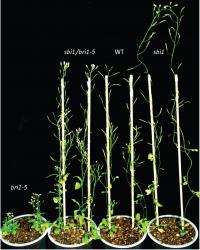Plants switch off growth signals by targeting 'used' receptor molecules for destruction

Plants coordinate growth using hormones called brassinosteroids (BR), and defects in the associated signaling pathway can result in profoundly stunted development. For example, researchers have identified numerous mutations within the gene encoding the BR receptor, BRI1, which yield plants with a dwarf phenotype.
The bri1-5 mutation does not directly disrupt receptor function, but nevertheless inhibits growth of thale cress, Arabidopsis thaliana, plants by somehow accelerating the rate of receptor degradation. The discovery of an additional mutation that fully counteracts this effect has now revealed valuable insights into how plants manage to keep a tight rein on growth signals1.
When Guang Wu and Joanne Chory of the Salk Institute for Biological Studies, USA, identified this enigmatic sbi1 mutant (Fig. 1), they partnered with Yuji Kamiya, a biologist at the RIKEN Plant Science Center in Yokohama. “We wanted to know the reason why sbi1 plants recover from the dwarf phenotype,” says Kamiya, “and so Wu visited my laboratory to study the mechanism of the BRI1 gene.”
An initial series of experiments provided strong evidence that the sbi1 mutant disrupts the function of a negative regulator of BRI1, which appears to act on the receptor after it has been activated by binding BR. The researchers were subsequently able to uncover the affected SBI1 gene, which encodes a member of the leucine carboxylmethyltransferase (LCMT) enzyme family.
LCMTs selectively attach methyl chemical groups onto the catalytic subunit of protein phosphatase 2A (PP2A), a multi-protein complex that deactivates a variety of receptors and other signaling proteins. Accordingly, Wu, Kamiya and colleagues found evidence that SBI1 methylates PP2A within Arabidopsis cells. This chemical modification activates the complex and alters its localization within the cell, bringing it into close proximity to BRI1 and thereby enabling it to switch off the receptor. SBI1 production is directly stimulated by BR signaling, further reinforcing this negative feedback loop.
These newly inactivated receptor molecules appear to be subsequently targeted for destruction. “We found that activated receptors that have bound BR transfer their signal to the nucleus and then get degraded, while unbound BR receptor is recycled rather than being degraded,” explains Kamiya. “By this mechanism, receptor levels are controlled in plants.”
Although similar regulatory systems are known to operate in animal cells, PP2A function is poorly understood in plants, and further investigation will be needed to determine whether this represents a general mechanism for constraining receptor signaling in Arabidopsis and other species.
More information: Wu, G., et al. Methylation of a phosphatase specifies dephosphorylation and degradation of activated brassinosteroid receptors. Science Signaling 4, ra29 (2011).
Provided by RIKEN


















